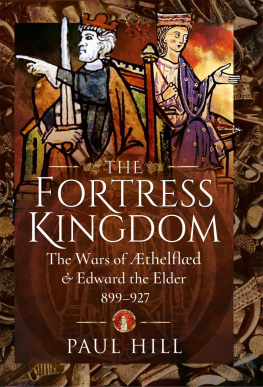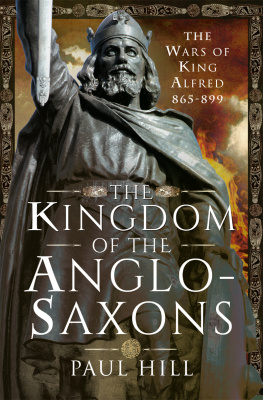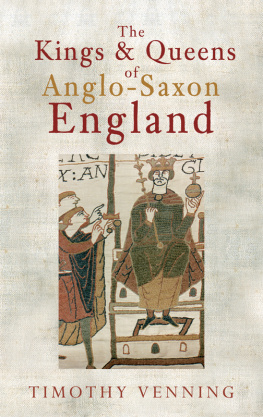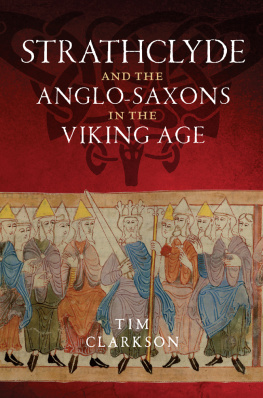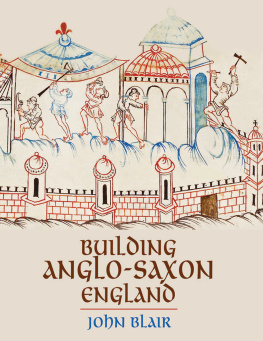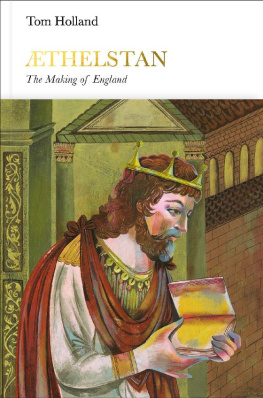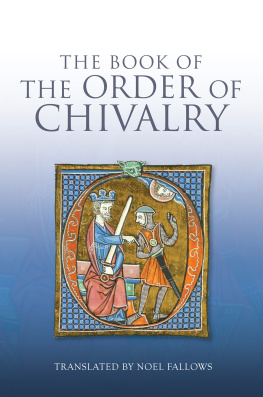Pagebreaks of the print version

Founder, Fighter, Saxon Queen
In memory of my Uncle Simon who loved medieval history and admired strong women
Founder, Fighter, Saxon Queen
Aethelflaed, Lady of the Mercians
Margaret C. Jones
First published in Great Britain in 2018 by
PEN AND SWORD HISTORY
an imprint of
Pen and Sword Books Ltd
47 Church Street
Barnsley
South Yorkshire S70 2AS
Copyright Margaret C. Jones, 2018
ISBN 978 1 52673 396 2
eISBN 978 1 52673 397 9
Mobi ISBN 978 1 52673 398 6
The right of Margaret C. Jones to be identified as the author of this work has been asserted by her in accordance with the Copyright, Designs and Patents Act 1988.
A CIP record for this book is available from the British Library All rights reserved. No part of this book may be reproduced or transmitted in any form or by any means, electronic or mechanical including photocopying, recording or by any information storage and retrieval system, without permission from the Publisher in writing.
Pen & Sword Books Ltd incorporates the imprints of Pen & Sword Archaeology, Atlas, Aviation, Battleground, Discovery, Family History, History, Maritime, Military, Naval, Politics, Railways, Select, Social History, Transport, True Crime, Claymore Press, Frontline Books, Leo Cooper, Praetorian Press, Remember When, Seaforth Publishing and Wharncliffe.
For a complete list of Pen and Sword titles please contact
Pen and Sword Books Limited
47 Church Street, Barnsley, South Yorkshire, S70 2AS, England
E-mail:
Website: www.pen-and-sword.co.uk
List of Illustrations
Aethelflaed, by Anna Fenn, from the E2BN Historys Heroes website. (historysheroes.e2bn.orgherowhowerethey4292).
thelfld, Cartulary of Abingdon Abbey, thirteenth century. (British Library MS, Cotton Claudius B VI folio 14r).
Detail from Aethelflaed window in St Andrews, Churchdown. George Cooper-Abbs, 1934.
Aethelflaed of Mercia, ad 917. (Gambargin, Women War Queens series.)
Layout of a typical burh, based on the burh at Oxford.
The Market Cross, Gloucester, with St Michaels Tower.
Aethelflaeds Gloucester.
Plaque in Castle Street, Warwick, commemorating Aethelflaeds founding of the town in ad 914.
City wall, Chester.
Aethelflaeds burhs and battles, ad 900 to 917.
Detail from Steve Fields Caryatid Gate, Wednesbury.
thelfld in a thirteenth-century genealogy. (British Library, MS Royal14 B V.)
La Sage Aethelflaed, in a fourteenth-century genealogy. (British Library, MS Royal 14 B VI.)
St Oswalds Priory, Gloucester.
Aethelflaed Churches and shrines, ad 900 to 918.
Ethelfleda, in Chester Cathedral, by W.T. Carter Shapland.
Aethelflaed statue by Edward George Bramwell (1913), in Tamworth.
Earl Ferrers unveiling the Tamworth statue in 1913. Reproduced in Tamworth Herald , 18 January 2013. http://www.tamworthherald.co.uk/forgotten-big-anniversary/story-17892962-detail/story.html#1
Millenary pageant procession in Tamworth, 1913. (Tamworth Herald , 18 January 2013.)
Ethelfleda Bridge, Runcorn.
Holding back the Vikings at Runcorn.
Aethelflaed taking hostages at Brecon Mere (Llangorse). By Richard Caton Woodville, in Hutchinsons Story of the British Nation , 1922.
Ethelfleda Terrace, Wednesbury.
Ethelfloeda. Detail of Benjamin Fletchers sculpture of 1922, in Leicester.
Watch on the Mersey. Angela Sidwells sculpture at Runcorn.
Wrought iron fence on Runcorn waterfront.
Aethelflaed Gruit Ale. Advertisement designed by Jose Carmona. (Courtesy of Sacre Brew Company).
Aethelflaed models for Bad Squiddo games.
Preface
Shes buried in my back garden.
This casual remark in a Gloucester lecture room caused heads to turn, and surprised laughter to ripple round the hall. That Aethelflaed, daughter of King Alfred the Great was claimed to have her last resting place behind a private house in a quiet Gloucester back street, might sound delusional, the grandiose brag of a fantasist. But the St Marys Street resident had a case. His garden, like that of his next door neighbour Rebecca Trimnell, overlooks the ruins of St Oswalds, founded as a church in the tenth century. The founder was Aethelflaed. For seven years after her husbands death until her own in ad 918, this strong-minded woman ruled over the Anglo-Saxon kingdom of Mercia, a territory that stretched from Gloucester to Northumbria, and from Derby to the Welsh borders.
The first point to strike those who have written about Aethelflaed from the twelfth century to the present, is that she did what no Anglo-Saxon woman before her had done she led her army in battle. But no Anglo-Saxon woman was expected to negotiate treaties either, or to be a town planner, or, in widowhood, to rule a kingdom in her own right to collect taxes, hear appeals and administer the law. These aspects of the career of the Lady of the Mercians, as she was known to her subjects, are where Aethelflaeds real achievement lies. Many decisions that she took, in the previously unheard-of role of de facto queen of Mercia, changed the face of England.
To come back to Gloucester: Aethelflaed and her husband had arranged to be buried in a crypt at the eastern end of St Oswalds, in an area now covered by potting sheds and private lawns. An archaeological dig on this site in the mid-1970s uncovered the remains of thick stone walls. They appeared to mark the sides of a freestanding building, quite possibly the royal mausoleum. Treacherously sliding loose sand made it risky to excavate further, however, and the diggers gave up.
That we cant be certain exactly where Aethelflaed was buried hardly matters. Her name lives on. The Lady of the Mercians was a queen in all but name and the Irish, who admired her, called her just that. Like her more famous father, she is great in her own right. She fought against Viking raiders, and built fortified towns to protect her people from attack. For the part she played in preparing her Midlands kingdom to become part of a unified England, she has been called Englands founding mother.
When her husband died in ad 911, Aethelflaed inherited the rule of a war-ravaged land. Under continuing attack from Danish and Norse Vikings, she drove back the raiders, and brought Danish-occupied parts of Mercia back under Mercian control. A skilled diplomat, she negotiated treaties with her neighbours even with former enemies, when the time was right to create a safer world for her people. In the conditions of peace made possible by her rule, industry and trade flourished. She founded shrines and churches. Most importantly for us, her inheritors, she fortified towns all across Mercia, and built new ones, protecting the inhabitants from attack and enabling these protected enclaves to prosper and grow.
Her building programme transformed the landscape. Many of the urban centres we know today Chester, Stafford, Shrewsbury, Tamworth, Warwick are Aethelflaeds gift to the Midlands. When you walk along the High Street in Warwick, or stroll around the four crowded and lively intersecting streets at the heart of Gloucester, you are following urban layouts decreed by the Lady of the Mercians.
There had been powerful Anglo-Saxon queens before Aethelflaed, exercising power as the wife of a king; and this was particularly true of Mercia. But Aethelflaeds choice to rule alone after her husbands death, instead of retiring quietly to a nunnery as royal widows were usually expected to do, was unique. Still more radical, was her attempt before her own death, to pass on the rule of Mercia to her daughter Aelfwynn. One woman would not again succeed another on a throne in England for 600 years when Elizabeth I inherited the title of queen after the death of Mary Tudor.


